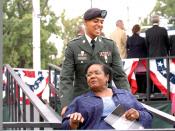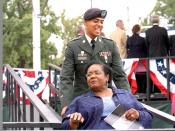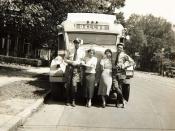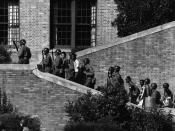Review of Melba Pattillo Beals' Warriors Don't Cry Melba Pattillo Beals has written a compelling story, which has documented her experiences in the early days of the Civil Rights movement. In the 1950s, Little Rock, Arkansas was a chaotic hub of blatant racism. This book has recreated for its readers the integration of Central High School, a prestigious all white high school in Little Rock. The story Beals has told is one of daily abuse""being kicked, punched, shoved down staircases, having her feet stomped on, being spat on, having dangerous acid thrown in her face, and nearly being set on fire. Beals feels "my eight friends and I paid for the integration of Central High with our innocence"� (2).
In May of 1954, the Supreme Court ruled in the case of Brown v. Board of Education of Topeka, Kansas that separate public schools for whites and blacks were illegal.
This breakthrough ruling brought turmoil to Little Rock, giving whites and blacks alike a sense of uneasiness. By 1955, the Little Rock school board had adopted a plan to limit integration in their city to one school, Central High. The actually integrating would not take place until September 1957. The nine Negroes chosen to integrate were selected on a basis of scholarship, personal conduct, and health. The young pioneers who broke the color barrier at Central High School were leaders of a long hard fight for equality.
These students, referred to as the "Little Rock Nine"� literally put their lives on the line to fight for what they believed in. They suffered many forms of severe physical and mental abuse. Aside from being strictly prohibited from retaliating in any way to their abusers, the "Little Rock Nine"� were separated from each other entirely. No two of the children were ever in the same class at the same time. This separation from one another created an open playground for brutal attacks. "The stairwells were huge, open caverns that spiraled upward for several floors providing ample opportunity to hurl flying objects, dump liquids, or entrap us in dark corners"� (152). Going to school each day proved to be a downhill battle.
Teachers and administrators routinely refused to help these victims of cruel acts, and rarely disciplined their attackers. "The teacher sat meekly behind his desk, a spectator stripped of the desire or power to make them behave"� (141). Many prominent members of the town openly conspired in an attempt to force these children to leave the school, or to compel their parents to withdraw them. In a sense, the blacks went through almost as much humiliation and terror as the Jews did in the Holocaust. There were many similarities in the two situations such as the Jewish people had to flee from the Nazis to save their lives, and they were always being watched. These war-like surroundings taught Jews and blacks alike the tactics necessary for survival.
Racism has had a lengthy, grueling record in our country. In fact, during the 1950s, segregation was legal in most southern states. Prior the Civil Rights movement, our America was separated by color. In this time period, black people were thought of as "second-class citizens"�, and most accepted these chauvinistic ideals. "The humiliating expectations and traditions of segregation creep over you slowly stealing a teaspoon of you self-esteem each day"� (6). Day to day living was a constant struggle for people of color.
Drawn from the diaries she kept, the author easily put readers in her shoes as she struggled against those people in both the white and black communities who fought for segregation to continue. Her writing style does not play on the sympathy of readers; it simply tells it like it happened. She shared the physical, mental, and emotional torture and abuse she suffered at the hands of teenagers and adults alike. She also shared the support, the encouragement, and the help she received from people of all races.
This book captures the promise of America and along with it the need to really know our history. Melba Pattillo Beals has recorded her story as it happened to her at the tender age of 15. But it has taken her all these years to revisit it. This book describes the horror of racism, but equally, the courage it took for nine black teenagers to integrate Central High School in 1957. Beals has compiled a powerfully written history lesson and a coming of age story all into one by telling how she and her friends lost their innocence and sense of simplicity that year in Little Rock, Arkansas.






